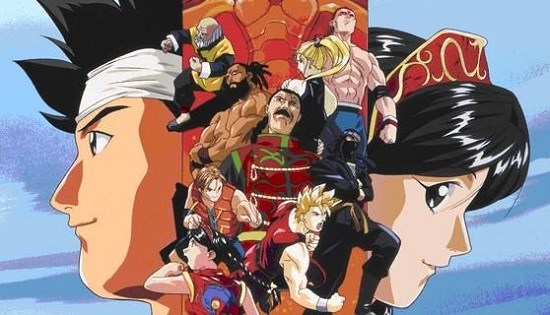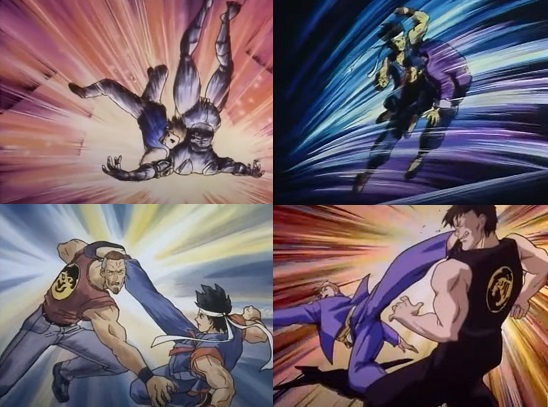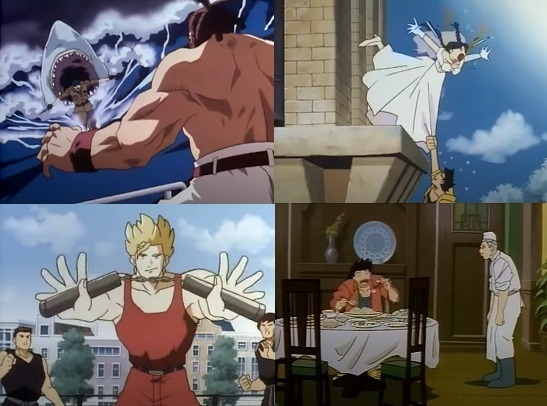
Written by Robert Frazer on 12 Aug 2021
Distributor YouTube • Certificate N/A • Price N/A
In the 2020 Recommendations article I claimed that the Virtua Fighter anime is the best adaptation of a beat-‘em-up videogame that’s ever been produced. That’s a bold statement, especially considering that the Virtua Fighter anime was originally broadcast way back in 1995-6! Am I really saying that in the whole quarter-century that’s passed since then, with all the increased sophistication of writing and technology that’s grown as part of the anime industry’s evolution of art and craft alike, Virtua Fighter has really never been bettered? Indeed, I am – and as I appreciate that it seems astonishing, I didn’t just want to leave it in an unsupported line buried in another article but dedicate a proper review to explaining why Virtua Fighter deserves a gleaming trophy in its silver year.
Part of the reason for bringing up Virtua Fighter in the first place was to grant a much-needed spotlight on the “Anime! on TMS Official Channel” on YouTube. While it is fair to say that we’ve never had it so good when it comes to both the choice and affordability of anime – if you’ve ever grumbled about the cost of a season’s box set in HMV bear in mind that fifteen years ago you’d be paying that amount for a single four-episode disc – it is also true that the privations of the pandemic have had an effect on many people too. Many have lost their jobs and even those who have kept them have lost income, and we still face an uncertain future. Anime can be a source of relief and a refuge away from these problems, but in straitened circumstances where we’re feeling the pinch of tightened belts it is one that can become difficult to sustain. A Crunchyroll subscription, a Funimation Now subscription, Netflix, Amazon Prime, Hi-Dive… little bits mount up into a lot. Earlier in 2020 I promoted the free anime being offered on the “All 4” streaming app as a way to relieve the pressure on your wallet, but if you’ve already worked your way through their selection in the months since then, the Japanese anime studio TMS has stepped in to fill the gap with a number of different shows it has produced over the years streaming for free on YouTube.
I’m surprised at how completely anonymous the TMS YouTube channel has been. The channel has over 450,000 subscribers, but despite that I’ve never seen it discussed once anywhere else in the entire online anime community. Moreover, the videos themselves don’t always seem to have attracted that much attention – while there’s one fairly random Sonic X clip that seems to have been blessed by the Almighty Algorithm as it’s attracted over four hundred thousand views, even the most active uploads are only in five figures which actually isn’t all that great for YouTube ad revenue. It seems that by operating this channel TMS is being genuinely charitable and that deserves more appreciation than it has been receiving up to now.
Charitability doesn’t mean limitations either, because even if the YouTube catalogue is not very extensive it is quite eclectic, fitting in one representative each for a range of different genres suiting a diversity of tastes: monstergirl romance in Actually, I Am… (interestingly Seven Seas has already been publishing the manga version of this show under an invented but more usefully descriptive alternative title of My Monster Secret); shonen adventure in KenIchi The Mightiest Disciple; traditional Japanese folklore in We Rent Tsukumogami; trading card game tie-in Cardfight Vanguard; there’s even a Lupin III sampler, and a number of anime dubbed into French and Spanish for a more international audience. Out of all of these and others though, why have I picked out Virtua Fighter as the feature title of the channel?
That there is a Virtua Fighter anime at all is a feat in and of itself. Now, the Sega Saturn is a tragically underappreciated games console and remains my favourite to this day, but I can’t deny the objective fact of history that in the West the Saturn was a commercial failure which confirmed Sega’s slide towards final defeat in the Console Wars. That said, the console was much more successful in Japan than it was in the USA or UK – and a good part of that success can be attributed to Virtua Fighter. In English-speaking territories Virtua Fighter was just one among many in the beat-‘em-up genre and while it earned some kudos for pioneering 3D graphics in a fighting game it was rapidly eclipsed by louder, flashier competitors like Tekken, Soul Edge or even Battle Arena Tohshinden; in Japan, however, Virtua Fighter was an institution unto itself. That alone though is not enough for an anime: Virtua Fighter is regarded as a “technical” fighting game and intimidatingly hard to access, stripping away spectacle and confronting newcomers with an uncompromisingly demanding focus on austere precision of technique: the Gran Turismo of beat-‘em-ups, if you would. There are no Super Bars or Pinch Modes to get you out of a jam – you master the timing of the PPPK combo or you may as well tip all your quarters down the drain. The purist combat also excludes most other appeal – there are no cutscenes in a Virtua Fighter game and almost nothing in the way of characterisation: most of the fighters may as well be mannequin puppets for their limited personality, and they also form one of the most conservatively-dressed rosters in the genre (Dead or Alive: Extreme Beach Volleyball it most certainly ain’t). There wouldn’t seem to be much material with which to make an anime out of in the first place, but Virtua Fighter astoundingly manages it.

In the world of Virtua Fighter, Akira Yuki is a young adult and a karate prodigy. His trophy cabinet is groaning under the weight of dozens of medals and awards from winning tournaments, but Akira has been forced to leave it all behind – his grandfather and mentor was completely unimpressed by Akira’s great victories, denouncing his grandson as a superficial glory-hound distracted by fame and fortune and forgetting the spiritual, meditative core of martial arts. Chastened by such castigation, Akira has been wandering the USA seeking the contemplative truths that will clear his mental vision and enable him to see the heavenly stars again… or at least he would be, if he wasn’t weighing down his steps by being a comically chronic over-eater!
I can only breathe in my waistband and stare with bitter envy at Akira’s fast metabolism, because he can strip the kitchen of an entire restaurant and still have room for seconds. His travels have taken him to an eatery in San Francisco’s Chinatown which is rumoured to have the finest pork dumplings on the West Coast – and that’s where adventure finds him, as he stumbles into Pai Chan, a Chinese Triad princess who’s trying to escape to live her own life and avoid being dragged back to Hong Kong for a forced mafia marriage to the evil international society Koenkan! It’s all a rather tedious distraction from Akira’s quest to shovel down yet more plates of gyoza, but then it occurs to him that becoming Chinatown’s knight-errant protecting the people from the Koenkan’s rackets… is a great way to be rewarded with free food!
It all sound quite simple and straightforward – and that is the secret to Virtua Fighter’s success. Fighting games have placed increasing emphasis on story over time – the boxed edition of Guilty Gear Xrd even came with a complete OVA disc included! – and I’ve always found that strange, because decades later the stories still remain complete and utter cobblers. Street Fighter takes itself so leadenly and ploddingly seriously it’s achieving the gymnastic feat of turning itself inside-out as it steadily pushes its head up its own backside; I gave up the single-player mode of BlazBlue halfway through as it just descended into complete and utter incomprehensibility; and how Mortal Kombat changed the poster pose of one of its main characters, Johnny Cage, from doing the ‘OK’ sign to flipping the bird at the player is a dry summation of how glum and mean-spirited it’s become.
Virtua Fighter is not weighed down by all of this ponderous narrative baggage and it’s an anime with a refreshing lack of self-consciousness and pretension. From the city being terrorised by an evil crime-syndicate-cum-Eighties-corporation-cum-karate-dojo (complete with the clan’s footsoldiers stalking the streets in black karategi) to the overarching plot amounting to a fighting tournament being used as cover to programme a new generation of super-soldiers, Virtua Fighter’s storyline never aspires to be anything more than unabashed chop-socky kung fu and is all the better for it.
Shouldn’t that get it dismissed for being “simplistic” and “generic”, though? Why am I giving Virtua Fighter a pass? This is because it matches the story with the right attitude, bouncing along in a fundamentally light-hearted manner. Akira himself showcases this – at a glance, you would think he’s no more than Virtua Fighter’s cheap knock-off clone of Street Fighter’s Ryu but their personalities are completely different. Whereas Ryu is frankly as dull as dishwater with his singular monkish devotion to eternal training, Akira is a comic foil who is silly and capering throughout, and he only switches into his karate uniform after a henshin. Characters are Virtua Fighter’s strong suit and the four heroes that coalesce to form the main party – Akira, Pai, and the series’ American sibling duo Jacky & Sarah Bryant – are a larger-than-life bunch and brimming with personality, typified by the heaps of familial bickering that ensues as they traipse around the US in an R.V. seeking adventure. That mode of transportation is in itself comically understated, especially when it comes to them playing chicken with a gang of Koenkan road warriors in sports cars on the interstate!
Voice work is also key to successfully communicating these characterful interactions. TMS is providing the English-dubbed version of Virtua Fighter on YouTube: this version was originally released by Media Blasters, an outfit that is maybe somewhat notorious with a reputation as the Roger Corman of Western anime licensing but the cast here does have good direction. They keep in tune with the chopsocky atmosphere with animated exchanges and plenty of levity. The Virtua Fighter dub is so old it dates back to the days when incomplete licensing arrangements forced companies to re-arrange English dubbed versions of the theme songs, and while Virtua Fighter’s opening song is an almost-inaudible mumble and not remotely as memorable as, say, Tenchi Muyo’s “Pioneer”, it is still at least an interesting little window into anime history.

It’s not all fun and games, though. Fighting anime do need some, well, fighting and in this respect Virtua Fighter acquits itself excellently. While it’s not a festival of lavish sakuga – remember that this television series is still over 25 years old – it works well within the confines of its budget and shows much more martial action than more modern fighting game anime which have whole hard drives stuffed full of elaborate digital frippery to assist them (like the notoriously cheap BlazBlue anime). Virtua Fighter achieves this balance via a deft contrast – even though the story is silly, the fighting is actually relatively realistic. One of the features that distinguishes the game of Virtua Fighter from its beat-‘em-up counterparts is grounded combat: as I mentioned earlier in the review, there was a deliberately dearth of spectacle. There were no Street Fighter hadokens or Guilty Gear Dragon Installs, and bar some big floaty jumps in the early game (which were phased out as the series went on) all of the fighters’ moves are entirely realistic. This carries through into the anime as well – while occasionally fighters may radiate a glow of power to artistically reflect their inner strength of conviction and resolve, the actual fighting itself stays strictly to the weapons that God has given us – punches, kicks, grabs and throws. This makes even the minor skirmishes interesting as it’s never going to degenerate into an over-9000 power-level shriek-out. A particular feature of every episode which might be as formulaic as a henshin but nonetheless never fails to be interesting is that the episode’s major fight scene will culminate in a extravagant martial-arts special-move technique which is introduced with a Harmony Process freeze-frame and then stepped out as though it’s a diagram from a manual, while a hammy commentator effuses about its immeasurable stopping power. It’s a neat microcosm of how well Virtua Fighter juggles down-to-earth combat with larger-than-life scenarios.
Given how fun Virtua Fighter can be, an unfortunate sin of omission in the series is that it doesn’t really take any opportunity to exploit the Sega license. For instance, in one early episode the aspiring race driver Jacky competes in a stock-car tournament but we don’t get a single Daytona USA reference! Not even a “Let’s Go Away?” Just one? Please? No? Aww, what a waste. Ramping up the fanservice of videogame references could have made this a gamer’s delight.
It also needs mentioning that what TMS is offering us is exactly the original Media Blasters licensed version of Virtua Fighter – to a fault. In fact, I think that these online videos might literally be straight rips of old VHS editions because not only is the image transfer quite fuzzy (this is not at all a HD remaster) every few episodes there’s a second credits sequence on a plain black screen which runs through the English-language staff, as though it was the end-of-videotape staff call. This means that not only is this just the English-dubbed version with no Japanese (if you prefer the original experience you can watch the subtitled version of Virtua Fighter on the Retro Crush anime streaming platform, but that is not currently available in the UK), it also means that you aren’t actually getting the complete series. The dubbed version of Virtua Fighter came out in 1999, when the Saturn had already failed in the West and the Dreamcast wouldn’t be released until late in the year: any buzz around Virtua Fighter had long since dissipated and the anime was not a sales success for Media Blasters. 35 episodes were produced in Japan, but Media Blasters only released 24 before discontinuing the series – so only 24 are available on YouTube as well. This means that the story is incomplete, and while I’ve shrugged that off with other streaming series such as Lupin III, Part 2 as Virtua Fighter is not episodic but does tell a continuous story that does mean that there’s a frustrating gap in the tale.
Nonetheless, even an incomplete tale is still an entertaining one when it’s being given to you for free. Virtua Fighter is a hugely enjoyable anime whose spirit still shines even decades after it was done.

Robert's life is one regularly on the move, but be it up hill or down dale giant robots and cute girls are a constant comfort - limited only by how many manga you can stuff into a bursting rucksack.
by Ross Locksley on 21 Dec 2025
by Ross Locksley on 25 Nov 2025
by Ross Locksley on 24 Nov 2025
by Ross Locksley on 11 Nov 2025
by Ross Locksley on 08 Nov 2025
by Ross Locksley on 07 Nov 2025
by Ross Locksley on 05 Nov 2025
by Jamie Morris on 27 Oct 2025